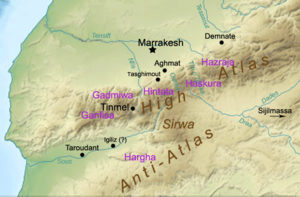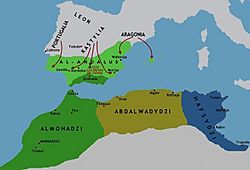Almohad Caliphate facts for kids
Quick facts for kids
Almohad Caliphate
ٱلْمُوَحِّدُونَ
al-Muwaḥḥidūn |
|||||||||||||||||||||||||||||||||||||
|---|---|---|---|---|---|---|---|---|---|---|---|---|---|---|---|---|---|---|---|---|---|---|---|---|---|---|---|---|---|---|---|---|---|---|---|---|---|
| 1121–1269 | |||||||||||||||||||||||||||||||||||||

The Almohad empire at its greatest extent, c. 1180–1212
|
|||||||||||||||||||||||||||||||||||||
| Status | Caliphate (from 1147) | ||||||||||||||||||||||||||||||||||||
| Capital | |||||||||||||||||||||||||||||||||||||
| Common languages | Berber languages, Arabic, Mozarabic | ||||||||||||||||||||||||||||||||||||
| Religion | Islam (Almohadism) | ||||||||||||||||||||||||||||||||||||
| Government | Caliphate | ||||||||||||||||||||||||||||||||||||
| Mahdi | |||||||||||||||||||||||||||||||||||||
|
• 1121–1130
|
Ibn Tumart | ||||||||||||||||||||||||||||||||||||
| Caliph | |||||||||||||||||||||||||||||||||||||
|
• 1130–1163 (first)
|
Abd al-Mu'min | ||||||||||||||||||||||||||||||||||||
|
• 1266–1269 (last)
|
Idris al-Wathiq | ||||||||||||||||||||||||||||||||||||
| History | |||||||||||||||||||||||||||||||||||||
|
• Established
|
1121 | ||||||||||||||||||||||||||||||||||||
|
• Almoravids overthrown
|
1147 | ||||||||||||||||||||||||||||||||||||
| 1212 | |||||||||||||||||||||||||||||||||||||
|
• Marinid suzerainty
|
1248 | ||||||||||||||||||||||||||||||||||||
|
• Disestablished
|
1269 | ||||||||||||||||||||||||||||||||||||
| Area | |||||||||||||||||||||||||||||||||||||
| 1150 est. | 2,300,000 km2 (890,000 sq mi) | ||||||||||||||||||||||||||||||||||||
| 1200 est. | 2,000,000 km2 (770,000 sq mi) | ||||||||||||||||||||||||||||||||||||
| Currency | Dinar | ||||||||||||||||||||||||||||||||||||
|
|||||||||||||||||||||||||||||||||||||
The Almohad Caliphate was a powerful Muslim empire in North Africa during the 12th and 13th centuries. It was founded by a group of Berber tribes. At its strongest, the empire controlled a large part of the Iberian Peninsula (modern-day Spain and Portugal) and much of North Africa.
The Almohad movement began with a religious leader named Ibn Tumart. After his death, Abd al-Mu'min took over and officially founded the Almohad Caliphate. Around 1120, Ibn Tumart started a small Berber state in Tinmel, located in the Atlas Mountains.
Under Abd al-Mu'min (who ruled from 1130 to 1163), the Almohads defeated the Almoravid dynasty in Morocco in 1147. They captured Marrakesh and Abd al-Mu'min declared himself the caliph (a religious and political leader). By 1159, they had spread their power across all of North Africa. Soon after, they took control of Muslim Iberia by 1172.
A major turning point happened in 1212. The Almohad leader, Muhammad an-Nasir, was defeated at the Battle of Las Navas de Tolosa. This battle was fought against a group of Christian armies from Castile, Aragon, and Navarre. After this defeat, the Almohads lost many of their lands in Iberia. Cities like Córdoba and Seville fell to Christian forces in 1236 and 1248.
The Almohads continued to rule in Africa for a while. However, they slowly lost control as different tribes and regions rebelled. Their main rivals, the Marinids, rose to power in northern Morocco around 1215. The last Almohad ruler, Idris al-Wathiq, only controlled Marrakesh. He was killed in 1269, and the Marinids took over Marrakesh, ending the Almohad empire in the west.
Contents
History of the Almohads
How the Almohad Movement Began
The Almohad movement started with Ibn Tumart. He was a member of the Masmuda, a group of Berber tribes from the Atlas Mountains in southern Morocco. At that time, Morocco, western Algeria, and Spain were ruled by the Almoravids.
Ibn Tumart traveled to Spain and then to Baghdad to study religion. He developed his own religious ideas. His main belief was a very strict idea of tawhid, meaning the absolute unity of God. He believed that God's attributes could not exist separately from Him. His followers were called al-Muwaḥḥidūn, which means "those who believe in the unity of God." This is where the name "Almohads" comes from.
After returning to North Africa around 1117, Ibn Tumart preached his ideas. He criticized the Almoravid rulers, saying they were not strict enough in their faith. He also disagreed with their support for the Maliki school of Islamic law. His strong opinions often got him expelled from towns. In Mellala, he gained his first important followers, including Abd al-Mu'min, who would later become his successor.
In 1120, Ibn Tumart went to Fez and then Marrakesh. He challenged the Almoravid emir, Ali ibn Yusuf, and local scholars to a debate. The scholars thought his ideas were dangerous. The emir decided to simply send him away from the city.
Ibn Tumart found safety among his own people in the Sous valley. He lived a simple life in a cave, preaching his ideas for religious reform. More and more people came to listen. In late 1121, after a powerful sermon, Ibn Tumart announced that he was the true Mahdi. A Mahdi is a divinely guided leader. His followers accepted this, which was like declaring war on the Almoravid state.
In 1122, Ibn Tumart moved into the High Atlas mountains. He organized the Almohad movement among the mountain tribes. He gained support from several important Masmuda tribes. Around 1124, Ibn Tumart built a strong fort called the ribat of Tinmel. This fort became the Almohad's spiritual and military center.
For the first eight years, the Almohad rebellion was a guerilla war in the mountains. They made the roads south of Marrakesh unsafe, which affected trade. The Almoravids found it hard to fight them in the mountains. They built forts to try and keep the Almohads contained.
Ibn Tumart organized the Almohads with a clear structure. There was an inner council of ten close companions and a larger council of fifty tribal leaders. The army also had a strict hierarchy.
In 1130, the Almohads attacked the lowlands for the first time. They defeated an Almoravid army near Aghmat and chased them to Marrakesh. They surrounded Marrakesh for forty days. But in April or May 1130, the Almoravids attacked from the city. They crushed the Almohads in the bloody Battle of al-Buhayra. Many Almohad leaders were killed, and the survivors barely made it back to the mountains.
Ibn Tumart died shortly after, in August 1130. The Almohad movement did not fall apart, thanks to Abd al-Mu'min. Ibn Tumart's death was kept secret for three years. This gave Abd al-Mu'min time to become the new leader. In 1132, Abd al-Mu'min showed the Almohads were still strong by capturing and destroying the Tasghîmût fortress. Three years after Ibn Tumart's death, Abd al-Mu'min was officially named "Caliph."
To strengthen his power, Abd al-Mu'min relied on his own tribe, the Kumiyas. He brought many of them into the army and government. He also appointed his sons as governors. He even moved Arab families to Morocco to reduce the power of the Masmuda tribal leaders. These changes helped spread the Arabic language and culture in Morocco.
Almohad Expansion into Al-Andalus
Abd al-Mu'min became the main leader after Ibn Tumart. From 1130 until his death in 1163, he not only defeated the Almoravids but also expanded his empire across North Africa, reaching as far as Egypt. He became the emir (ruler) of Marrakesh in 1147.
Al-Andalus (Muslim Spain) soon followed. Between 1146 and 1173, the Almohads slowly took control from the Almoravids in Iberia. They moved the capital of Muslim Iberia from Córdoba to Seville. They built a large mosque there, and its famous tower, the Giralda, was built in 1184. They also built a palace in Seville called Al-Muwarak.
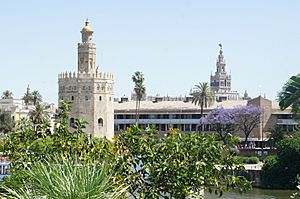
The Almohad rulers were very capable. Abd al-Mu'min's successors, Abu Yaqub Yusuf (ruled 1163–1184) and Abu Yusuf Yaqub al-Mansur (ruled 1184–1199), were strong leaders. At first, their strict rule caused many Jewish and Christian people to flee to Christian kingdoms. But later, they became less extreme. Ya'qub al-Mansur was a very educated man who wrote well in Arabic. He also protected the famous philosopher Averroes. In 1190–1191, he fought in southern Portugal and won back land. He earned the title "al-Manṣūr" ("the Victorious") for his victory over Alfonso VIII of Castile at the Battle of Alarcos in 1195.
Later Almohad leaders governed Iberia through local officials. They would cross the Straits of Gibraltar to lead holy wars against the Christians, then return to Morocco.
Challenges and Decline
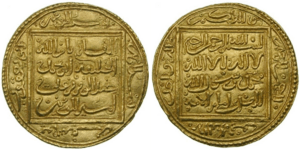
In 1212, the Almohad Caliph Muhammad an-Nasir (ruled 1199–1214) faced a major defeat. After some early successes, he was beaten by a group of Christian kings from Castile, Aragon, Navarre, and Portugal. This happened at the Battle of Las Navas de Tolosa in the Sierra Morena mountains. This battle stopped the Almohad advance. However, the Christian kingdoms were not organized enough to take full advantage right away.
Before he died in 1213, al-Nasir named his young ten-year-old son, Yusuf II, as the next caliph. During Yusuf II's rule, older family members and officials largely controlled the empire. The Almohad leaders made peace agreements with the Christian kingdoms, which mostly lasted for the next fifteen years.
In 1224, the young caliph Yusuf II died in an accident without any children. Officials in Marrakesh quickly chose his elderly grand-uncle, Abd al-Wahid I, as the new caliph. But this quick decision angered other family members, especially the brothers of the late al-Nasir, who ruled in Spain. One of them, Abdallah al-Adil, declared himself caliph and quickly took control of Spain. With help from his advisor, he managed to have Abd al-Wahid I removed and killed.
This internal power struggle greatly weakened the Almohads in Spain. It was the first time the Almohad family had such a violent internal conflict. Caliph al-Adil's actions made other Almohad leaders question his right to rule. One of his cousins, Abd Allah al-Bayyasi, the governor of Jaén, rebelled. He formed an alliance with the Christian king Ferdinand III of Castile. Al-Adil was more focused on Marrakesh, where other Almohad leaders supported Yahya, another son of al-Nasir. So, al-Adil paid little attention to al-Bayyasi's rebellion.
The Reconquista Begins
In 1225, Abd Allah al-Bayyasi and a large Castilian army attacked several cities, including Jaén and Andújar. They raided areas around Jaén and Cordova. By the end of the year, al-Bayyasi had taken control of Cordova. Seeing this weakness, the kings of León and Portugal also launched raids into Muslim territory.
With Almohad soldiers and money sent to Morocco to help Caliph al-Adil, there was little defense in Spain. In late 1225, Portuguese raiders easily reached the area around Seville. The Almohad governors in Seville refused to fight, so the people of Seville formed their own militia. This led to a terrible massacre, with thousands of poorly armed citizens killed by the Portuguese. Similar disasters happened elsewhere. Trust in the Almohad leaders was severely shaken.
Caliph al-Adil's situation improved briefly. Al-Bayyasi had given Ferdinand III of Castile three important forts in exchange for help. However, one fort, Capilla, refused to surrender, forcing the Castilians to lay a long siege. The bravery of Capilla and the sight of al-Bayyasi helping the Christian attackers shocked the people of Spain. Support shifted back to the Almohad caliph. A rebellion broke out in Cordova, and al-Bayyasi was killed. But Caliph al-Adil did not enjoy this victory for long. He was killed in Marrakesh in October 1227 by supporters of Yahya, who then became the new Almohad caliph, Yahya.
The Almohad leaders in Spain refused to accept Yahya. Al-Adil's brother, Abd al-Ala Idris I, who was in Seville, declared himself the new caliph. He quickly made a peace deal with Ferdinand III of Castile, paying him a large sum of money. This allowed him to send most of the Almohad army from Spain to Morocco in 1228 to fight Yahya.
In that same year, Portuguese and Leonese forces raided deep into Muslim lands without much resistance. Feeling abandoned by the Almohads, people across Spain rebelled. Many cities removed their Almohad governors and chose local leaders. A strong leader from Murcia, Muhammad ibn Yusuf ibn Hud al-Judhami, became the central figure of these rebellions. He systematically removed Almohad soldiers from central Spain. In October 1228, with Spain almost completely lost, al-Ma'mun left Seville and took the remaining Almohad army back to Morocco.
The departure of al-Ma'mun in 1228 marked the end of Almohad rule in Spain. Ibn Hud and other local leaders could not stop the growing Christian attacks. The next twenty years saw a huge advance in the Christian reconquista (reconquest). Many major cities fell to Christian forces: Mérida and Badajoz in 1230, Majorca in 1230, Cordova in 1236, Valencia in 1238, and finally Seville, the former Almohad capital, in 1248.
The Muslim people in Spain were helpless. Ibn Hud tried to stop the Leonese advance, but most of his army was destroyed in 1230. He tried to save cities under attack, but there were too many attacks at once. After Ibn Hud's death in 1238, some cities offered themselves back to the Almohads. But the Almohads did not return.
With the Almohads gone, the Nasrid dynasty rose to power in Granada. After the Christian advances from 1228 to 1248, the Emirate of Granada was almost all that was left of Muslim Spain. Granada remained independent for another 250 years, becoming a new center of Muslim culture.
Collapse in North Africa
In their African lands, the Almohads allowed Christians to live even in Fez. After the Battle of Las Navas de Tolosa, they sometimes made alliances with Christian kings. They also successfully removed the Norman garrisons from some coastal towns.
The Almohad empire declined differently from the Almoravids. They were not overthrown by a single large religious movement. Instead, they slowly lost territory as tribes and regions rebelled. Their most powerful enemies were the Banu Marin, who founded the next dynasty, the Marinids. The last Almohad ruler, Idris al-Wathiq, controlled only Marrakesh. He was killed in 1269, and the Marinids took over, ending the Almohad rule in the western Maghreb.
Culture and Achievements
Language and Learning
The Almohads valued the Berber language. Friday sermons (khuṭbas) were given in both Arabic and Berber. This was called "the western tongue."
The Almohad conquest of Spain caused many Andalusian Christians to move north to Christian lands. This affected the use of Romance languages in Almohad areas. After the Almohad period, Muslim lands in Spain were mostly limited to Granada. There, most people had converted to Islam, and speaking both Arabic and Romance languages seemed to disappear.
The Almohads tried to reduce the influence of the Maliki school of Islamic law. They even publicly burned copies of Maliki books. They wanted to spread the teachings of Ibn Tumart.
Despite the changes, learning continued. Almohad universities kept alive the knowledge of earlier scholars and ancient Greek and Roman writers. Important thinkers of this time included Ibn Rushd (Averroes), Ibn Tufail, and many poets and scholars. Many Jewish scholars, like Maimonides, left Almohad lands for more tolerant Muslim areas or Christian lands.
In the 12th century, under Sultan Abu Yusuf Yaqub al-Mansur, there were about 400 paper mills in Fez.
Art and Architecture
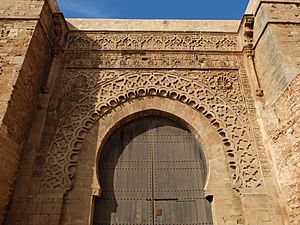
The Almohad period was very important for Moroccan and Moorish architecture. Many styles and designs that became common later were developed then. Key Almohad sites include Fez, Marrakesh, Rabat, and Seville. Almohad buildings were mostly made from rammed earth and brick, which were cheap and easy to find. Almohad builders improved how these materials were made and used, allowing for many large projects.
Early Almohad architecture was simpler in its decoration than earlier styles. It focused more on the overall shape of buildings. Almohad architecture combined Moroccan and Andalusian styles. Some elements, like polylobed arches, might have been influenced by architecture from Algeria and Tunisia. These arches were used for decoration, while horseshoe arches remained common. The decoration around the mihrab (prayer niche) in mosques became grander. This style also appeared in the large ceremonial stone gates of Almohad cities, like Bab Agnaou in Marrakesh and Bab Oudaia in Rabat.
The Kutubiyya Mosque in Marrakesh and the Tinmal Mosque are seen as models for later mosques in the region. The Great Mosque of Taza (started in 1142) is the oldest surviving Almohad mosque. Almohad mosques had large prayer halls with rows of arches. The main aisle leading to the mihrab and the aisle along the qibla wall (direction of prayer) were wider and more decorated. This "T-plan" became standard.
Almohad minarets (towers for calling to prayer) also set the standard for the region. They had a square base and a two-part shaft with decorative arches. The minaret of the Kasbah Mosque in Marrakesh was very influential. The most famous minarets are the Kutubiyya Mosque minaret (started 1147), the Giralda of Seville (started 1171), and the unfinished "Hassan Tower" of Rabat (started 1191).
The Almohads also built many strong walls and forts. They built or rebuilt the city walls of Cordoba, Seville, Fez, and Taza. In Rabat, Abd al-Mu'min built most of the Kasbah of the Udayas in 1150–1151. Abu Yusuf Yaqub al-Mansur started building a huge new capital and fortress called Ribat al-Fath in Rabat. This project created the outer walls of Rabat's historic center, including gates like Bab er-Rouah. Al-Mansur also built the Kasbah of Marrakesh, a large royal complex. In Seville, the Almohads built the Torre del Oro, a defensive tower on the Guadalquivir River, around 1220–1221. The Calahorra Tower in Cordoba is also thought to be an Almohad structure.
Almohad rulers also built country estates outside major cities. These estates often had large water basins or reservoirs that watered fruit orchards. Small palaces were built by these lakes. The Agdal and Menara gardens in Marrakesh grew from these Almohad creations. In Seville, parts of the al-Buḥayra garden, founded in 1171, have been found and restored.
-
Mihrab of the Great Mosque of Tinmal
-
La Giralda, the former minaret of the Great Mosque of Seville, built during the Almohad period
-
The south portico of the Patio del Yeso of the Alcázar of Seville, built during the Almohad period
-
Reservoir of the al-Buḥayra gardens in Seville, with remains of palace structure behind it (partly occupied by later building)
-
Hassan Tower in Rabat: an incomplete minaret intended for an enormous mosque begun by Ya'qub al-Mansur in the 1190s
-
Bab Agnaou, the original public entrance to the Kasbah of Marrakesh
-
The Almohad minaret in Safi
-
The Torre del Oro in Seville
Status of Non-Muslims
The Almohads took control of North Africa and Spain by 1147. They had a different view on the status of dhimmis. These were non-Muslim people living in a Muslim country who could practice their religion if they accepted Muslim rule and paid a special tax.
The treatment of Jews under Almohad rule was very different from before. During the earlier Caliphate of Córdoba, Jewish culture had a "Golden Age." Many Jews moved to Spain, where they were generally treated well and could practice their faith openly. Christians also practiced their religion openly in Córdoba and Morocco.
The first Almohad ruler, Abd al-Mumin, gave non-Muslims seven months to decide. Then, he forced most Jewish and Christian people in Moroccan cities to convert to Islam. Later, in 1198, the Almohad emir Abu Yusuf Yaqub al-Mansur ordered Jews to wear special dark blue clothes and large hats so they could be identified. His son changed the color to yellow. Those who converted to Islam were still made to wear special clothing, as they were not seen as truly Muslim. There are records of many Jews choosing to die rather than convert. Christians also faced persecution under Almohad rule.
Many conversions were not sincere. Famous Jewish scholar Maimonides advised Jews to pretend to convert rather than face death. He said, "Muslims know very well that we do not mean what we say." Many Jews fled from Almohad lands to Christian areas or to more tolerant Muslim countries in the East.
Later, Idris al-Ma'mun, an Almohad ruler in parts of Morocco (1229–1232), changed some of these rules. He allowed Jews to practice their religion openly in Marrakesh. He even allowed a Christian church there as part of his alliance with Castile. In Spain, Almohad rule ended in the 1200s. New smaller kingdoms took over, and they allowed Jews to practice their religion freely again.
List of Almohad Caliphs (1121–1269)
- Ibn Tumart 1121–1130
- Abd al-Mu'min 1130–1163
- Abu Ya'qub Yusuf I 1163–1184
- Abu Yusuf Ya'qub 'al-Mansur' 1184–1199
- Muhammad al-Nasir 1199–1213
- Abu Ya'qub Yusuf II 'al-Mustansir' 1213–1224
- Abu Muhammad Abd al-Wahid I 'al-Makhlu' 1224
- Abdallah al-Adil 1224–1227
- Yahya 'al-Mutasim' 1227–1229
- Abu al-Ala Idris I al-Ma'mun, 1229–1232
- Abu Muhammad Abd al-Wahid II 'al-Rashid' 1232–1242
- Abu al-Hassan Ali 'al-Said' 1242–1248
- Abu Hafs Umar 'al-Murtada', 1248–1266
- Abu al-Ula (Abu Dabbus) Idris II 'al-Wathiq' 1266–1269
| Almohad family tree | |||||||||||||||||||||||||||||||||||||||||||||||||||||||||||||||||||||||||||||||||||||||||||||||||||||||||||||||||||||||||||||||||||||||||||||||||||||||||||||||||||||||||||||||||||||||||||||||||||||||||||||||||||||||||||||||||||||||||||||||||||||||||||||||||||||||||||||||||||||||||||||||||||||||||||||||||||||||||||||||||||||||||||||||||||||||||||||||||||||||||||||||||||||||||||||||||||||||||||||||||||||||||||||||||||||||||||||||||||||||||||||||||||||||||||||||||||||||||||||||||||||||||||||||||||||||||||||||||||||||||||||||||||||||||||||||||||||||||||||||||||||||||||||||||||||||||||||||||||||||||||||||||||||||||||||||||||||||||||||||||||||||||||||||||||||||||||||||||||||||||||||||||||||||||||||||||||||||||||||||||||||||||||||||||||||||||||||||||||||||||||||||||||||||||||||||||||||||||||||||||||||||||||||||||||||||||||||||||||||||||||||||||||||||||||||||||||||||||||||||||||||||||||||||||||||||||||||||||||||||||||||||||||||||||||||||||||||||||||||||||||||||||||||||||||||||||||||||||||||||
|---|---|---|---|---|---|---|---|---|---|---|---|---|---|---|---|---|---|---|---|---|---|---|---|---|---|---|---|---|---|---|---|---|---|---|---|---|---|---|---|---|---|---|---|---|---|---|---|---|---|---|---|---|---|---|---|---|---|---|---|---|---|---|---|---|---|---|---|---|---|---|---|---|---|---|---|---|---|---|---|---|---|---|---|---|---|---|---|---|---|---|---|---|---|---|---|---|---|---|---|---|---|---|---|---|---|---|---|---|---|---|---|---|---|---|---|---|---|---|---|---|---|---|---|---|---|---|---|---|---|---|---|---|---|---|---|---|---|---|---|---|---|---|---|---|---|---|---|---|---|---|---|---|---|---|---|---|---|---|---|---|---|---|---|---|---|---|---|---|---|---|---|---|---|---|---|---|---|---|---|---|---|---|---|---|---|---|---|---|---|---|---|---|---|---|---|---|---|---|---|---|---|---|---|---|---|---|---|---|---|---|---|---|---|---|---|---|---|---|---|---|---|---|---|---|---|---|---|---|---|---|---|---|---|---|---|---|---|---|---|---|---|---|---|---|---|---|---|---|---|---|---|---|---|---|---|---|---|---|---|---|---|---|---|---|---|---|---|---|---|---|---|---|---|---|---|---|---|---|---|---|---|---|---|---|---|---|---|---|---|---|---|---|---|---|---|---|---|---|---|---|---|---|---|---|---|---|---|---|---|---|---|---|---|---|---|---|---|---|---|---|---|---|---|---|---|---|---|---|---|---|---|---|---|---|---|---|---|---|---|---|---|---|---|---|---|---|---|---|---|---|---|---|---|---|---|---|---|---|---|---|---|---|---|---|---|---|---|---|---|---|---|---|---|---|---|---|---|---|---|---|---|---|---|---|---|---|---|---|---|---|---|---|---|---|---|---|---|---|---|---|---|---|---|---|---|---|---|---|---|---|---|---|---|---|---|---|---|---|---|---|---|---|---|---|---|---|---|---|---|---|---|---|---|---|---|---|---|---|---|---|---|---|---|---|---|---|---|---|---|---|---|---|---|---|---|---|---|---|---|---|---|---|---|---|---|---|---|---|---|---|---|---|---|---|---|---|---|---|---|---|---|---|---|---|---|---|---|---|---|---|---|---|---|---|---|---|---|---|---|---|---|---|---|---|---|---|---|---|---|---|---|---|---|---|---|---|---|---|---|---|---|---|---|---|---|---|---|---|---|---|---|---|---|---|---|---|---|---|---|---|---|---|---|---|---|---|---|---|---|---|---|---|---|---|---|---|---|---|---|---|---|---|---|---|---|---|---|---|---|---|---|---|---|---|---|---|---|---|---|---|---|---|---|---|---|---|---|---|---|---|---|---|---|---|---|---|---|---|---|---|---|---|---|---|---|---|---|---|---|---|---|---|---|---|---|---|---|---|---|---|---|---|---|---|---|---|---|---|---|---|---|---|---|---|---|---|---|---|---|---|---|---|---|---|---|---|---|---|---|---|---|---|---|---|---|---|---|---|---|---|---|---|---|---|---|---|---|---|---|---|---|---|---|---|---|---|---|---|---|---|---|---|---|---|---|---|---|---|---|---|---|---|---|---|---|---|---|---|---|---|---|---|---|---|---|---|---|---|---|---|---|---|---|---|---|---|---|---|---|---|---|---|---|---|---|---|---|---|---|---|---|---|---|---|---|---|---|---|---|---|---|---|---|---|---|---|---|---|---|---|---|---|---|---|---|---|---|---|---|---|---|---|---|---|---|---|---|---|---|---|---|---|---|---|---|---|---|---|---|---|---|---|---|---|---|---|---|---|---|---|---|---|---|---|---|---|---|---|---|---|---|---|---|---|---|---|---|---|---|---|---|---|---|---|---|---|---|---|---|---|---|---|---|---|---|---|---|---|---|---|---|---|---|---|---|---|---|---|---|---|---|---|---|---|---|---|---|---|---|---|---|---|---|---|---|---|---|---|---|---|---|---|---|---|---|---|---|---|---|---|---|---|---|---|---|---|---|---|---|---|---|---|---|---|---|---|---|---|---|---|---|---|---|---|---|---|---|---|---|---|---|---|---|---|---|---|---|---|---|---|---|---|---|---|---|---|---|---|---|---|---|---|---|---|---|---|---|---|---|---|---|---|---|---|---|---|---|---|---|---|---|---|---|---|---|---|---|---|---|---|---|---|---|---|---|---|---|---|---|---|---|---|---|---|---|---|---|---|---|---|---|---|---|---|---|---|---|---|---|---|---|---|---|---|---|---|---|---|---|---|---|---|---|---|---|---|---|---|---|
|
|||||||||||||||||||||||||||||||||||||||||||||||||||||||||||||||||||||||||||||||||||||||||||||||||||||||||||||||||||||||||||||||||||||||||||||||||||||||||||||||||||||||||||||||||||||||||||||||||||||||||||||||||||||||||||||||||||||||||||||||||||||||||||||||||||||||||||||||||||||||||||||||||||||||||||||||||||||||||||||||||||||||||||||||||||||||||||||||||||||||||||||||||||||||||||||||||||||||||||||||||||||||||||||||||||||||||||||||||||||||||||||||||||||||||||||||||||||||||||||||||||||||||||||||||||||||||||||||||||||||||||||||||||||||||||||||||||||||||||||||||||||||||||||||||||||||||||||||||||||||||||||||||||||||||||||||||||||||||||||||||||||||||||||||||||||||||||||||||||||||||||||||||||||||||||||||||||||||||||||||||||||||||||||||||||||||||||||||||||||||||||||||||||||||||||||||||||||||||||||||||||||||||||||||||||||||||||||||||||||||||||||||||||||||||||||||||||||||||||||||||||||||||||||||||||||||||||||||||||||||||||||||||||||||||||||||||||||||||||||||||||||||||||||||||||||||||||||||||||||||
See Also
 In Spanish: Imperio almohade para niños
In Spanish: Imperio almohade para niños
- List of Mahdi claimants
- Mahdist War


